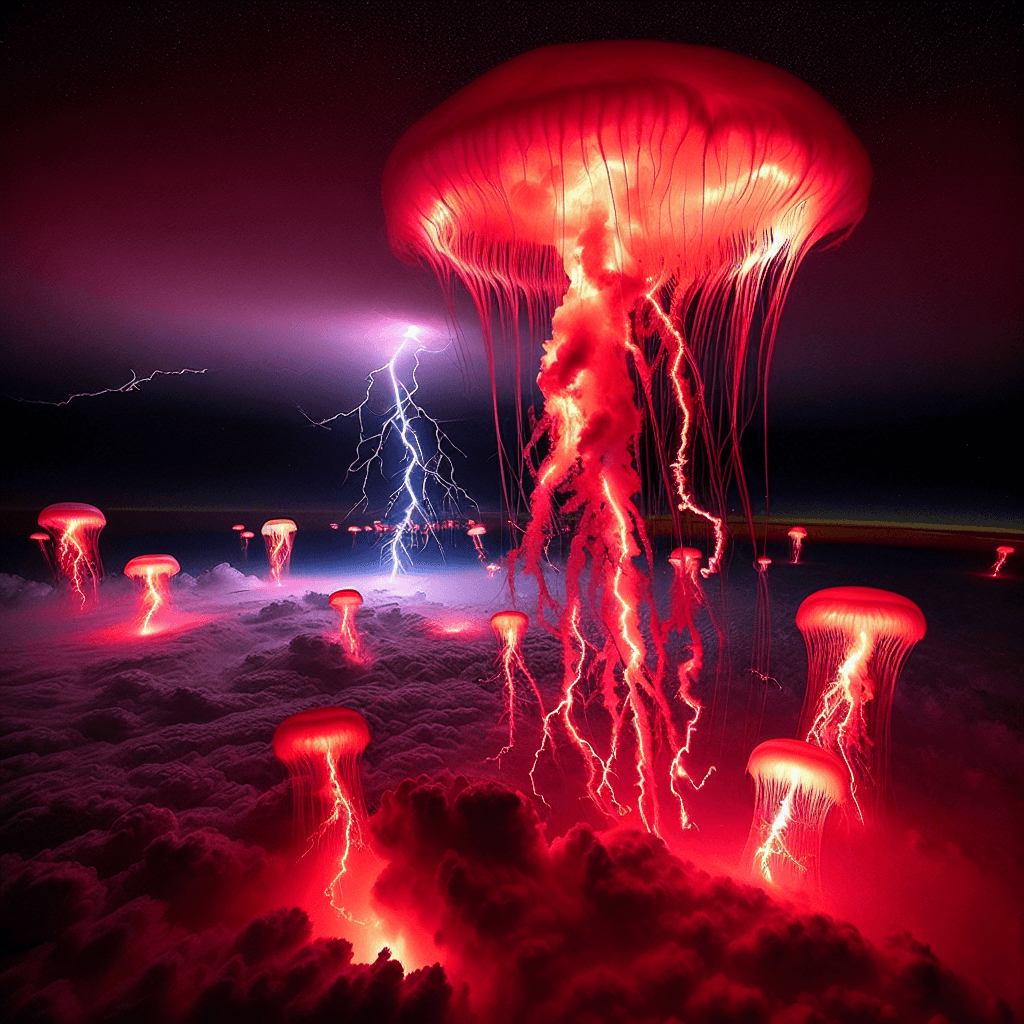Why do giant jellyfish made of red light briefly flash high above thunderstorms
High above the familiar flash of lightning, vast crimson apparitions bloom and vanish in an instant. Discover the secret electrical dance that connects powerful thunderstorms to these ghostly jellyfish at the very edge of space.


Too Long; Didn't Read
TLDR: Those red jellyfish are called sprites. They are massive electrical discharges in the upper atmosphere, triggered by powerful positive lightning strikes below the storm. This creates an intense electric field that makes nitrogen gas glow red, forming the brief, jellyfish-like shape.
Unveiling the Mystery: Why Do Giant Jellyfish Made of Red Light Briefly Flash High Above Thunderstorms?
Have you ever watched a distant thunderstorm, mesmerized by the raw power of lightning? While our eyes are typically drawn to the brilliant flashes below the clouds, one of nature's most spectacular and elusive light shows occurs far above them. For just a few milliseconds, colossal, jellyfish-like structures made of faint red light can erupt towards the edge of space. These are not UFOs or atmospheric anomalies; they are a stunning natural phenomenon known as "sprites." This blog post will explore the science behind these celestial phantoms, explaining what causes them, why they have their unique shape, and why they glow with an eerie red light.
What Are Sprites? Unmasking the Celestial Jellyfish
First, let's define what we're seeing. That giant red jellyfish is a "sprite," a type of Transient Luminous Event (TLE). TLEs are short-lived electrical discharges that happen high in the Earth's atmosphere, well above the altitudes where normal lightning and weather occur.
Here are the key characteristics of a sprite:
- Altitude: They occur in the mesosphere, a layer of the atmosphere roughly 50 to 90 kilometers (30 to 55 miles) above the ground. This is far above the 16 km (10 miles) altitude of a typical thundercloud.
- Size: Sprites are enormous. A single sprite can be up to 50 kilometers (30 miles) tall and just as wide, dwarfing the thunderstorm that creates it.
- Duration: They are incredibly brief, lasting for only a few thousandths of a second. This fleeting nature is why they were a mystery for so long, confirmed by camera only in 1989.
For decades, pilots reported strange, faint flashes above storms, but without evidence, their accounts were often dismissed. Today, we know sprites are a fundamental part of our planet's atmospheric electrical system.
The Cause: A Powerful Connection to Lightning Below
A sprite isn't a type of lightning itself, but rather the result of a specific and very powerful kind of lightning. They are triggered by a massive surge of electricity, but not just any lightning bolt will do. Sprites are almost always produced by positive cloud-to-ground (+CG) lightning.
Most lightning (over 90%) is negative, transferring a negative charge to the ground. Positive lightning is rarer but much more powerful, carrying a stronger electrical current. Here’s the step-by-step process that creates a sprite:
- A powerful +CG lightning strike suddenly removes a huge amount of positive charge from the top of the thundercloud, transferring it to the ground.
- This leaves the top of the cloud with a strong negative charge.
- This event creates a massive, temporary electrical imbalance between the top of the storm cloud and the positively charged upper atmosphere (the ionosphere).
- Nature abhors an imbalance. To neutralize this difference, a massive, but weak, electrical discharge erupts upwards from the top of the cloud. This high-altitude discharge is the sprite.
Think of it as the atmosphere's attempt to create an electrical short-circuit to restore balance on a planetary scale.
Why a Red Jellyfish? Explaining the Appearance
The distinct shape and color of a sprite are directly related to the altitude at which it forms.
The Ethereal Red Glow
The red color is a result of the atmospheric composition at 50-90 km. The air here is incredibly thin, but it is rich in nitrogen. The powerful electrical field of the sprite discharge excites these nitrogen molecules, kicking them into a higher energy state. As they immediately fall back to their normal state, they release that excess energy as photons of light. For nitrogen at these low pressures, the light is emitted primarily in the red part of the spectrum. It’s the same basic principle behind a neon sign, but on a cosmic scale with nitrogen gas instead of neon.
The Jellyfish Structure
The iconic "jellyfish" shape is a product of how the electrical discharge travels through the varying air pressure of the atmosphere.
- The "Head" or "Halo": The upper part of the sprite often forms a diffuse, glowing halo where the discharge begins in the thinnest part of the atmosphere.
- The "Tentacles": Below this halo, the discharge travels downward into slightly denser air. It forms into branching channels or streamers of plasma, creating the appearance of tentacles reaching down towards the storm cloud.
This intricate, branching structure is the path of least resistance for the electrical breakdown as it propagates through the incredibly thin air of the mesosphere.
Conclusion
The giant red jellyfish that flash above thunderstorms are not a mystery but a magnificent display of atmospheric physics. These sprites are a powerful reminder that our planet is a complex and dynamic system with wonders still being discovered. Caused by rare and powerful positive lightning strikes, their red glow comes from excited nitrogen in the thin air of the mesosphere, and their ghostly shape is a map of an electrical discharge unfolding at the edge of space. So, the next time you watch a storm from a safe distance, remember to look up. You might just catch a glimpse of one of nature's most beautiful and fleeting secrets.
More Articles

Why do movie punches sound so much crunchier and louder than real ones?
That sickening, bone-crunching punch you hear in the movies is a lie, and the secret ingredient is probably sitting in your refrigerator right now.

What makes a beer bottle suddenly foam over just from a light tap on top?
It’s not magic, it’s a shockwave; discover the explosive physics that turns a gentle tap on your beer bottle into an instant foamy geyser.

Why do police officers touch the back of a car during a traffic stop?
It’s not a random habit; that simple touch is a calculated, old-school tactic designed to leave a crucial and potentially life-saving piece of evidence behind.